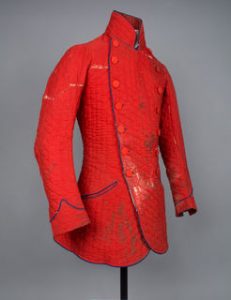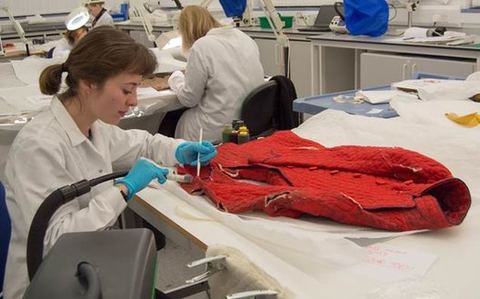A new foyer exhibition called “Blood, Sweat and Tears” opens at Dumfries Museum on 7 February.

Lieutenant-General Colin Mackenzie (1806 – 1881) was the son in law of Admiral John Douglas of Kinmount, near Annan in Dumfries and Galloway. His blood stained and slashed jacket was kept as a reminder of his lucky escape when he was attacked and nearly died in India in 1855.
2017 is Scotland’s Year of History, Heritage and Archaeology, celebrating the richness of Scotland’s intriguing history, cultural heritage and fascinating archaeology. The conservation of objects in museum collections adds to our knowledge of the past. Mackenzie’s jacket is on display for the first time since being conserved by student Hannah Vickers at the Centre for Textile Conservation at the University of Glasgow.
In 1850, Governor General of the East India Company, Lord Dalhousie, appointed Mackenzie as Brigadier-General in command of the Ellichpúr division of the Hyderabad contingent made up of infantry and cavalry. Generally the officers were British and the soldiers local men. Mackenzie was stationed at Bolarum, a suburb of Hyderabad in India.
In September 1855 cavalry soldiers defied orders and processed noisily past his house marking the Islamic religious month of Muhurram. This disregard of orders was one of many examples of responses to British expansion in India and suppression of historic traditions. A full scale rebellion (the first war of Indian Independence) took place in 1857 heralding the beginning of direct British rule in India (The Raj) which lasted until 1947.
According to accounts, Mackenzie confronted the soldiers passing his house. He was unarmed and was attacked. He suffered multiple sabre wounds to his arms, back and head and was extremely lucky to survive although he never fully recovered from his wounds.
Although Mackenzie’s bravery was commended, the British Government reprimanded him for his rash and ill-judged behaviour in sparking the incident in which he was injured. Mackenzie ended his military career as superintendent of army clothing in India. He returned to Britain in 1873 and died in Edinburgh in 1881.
It is difficult to know the full context of the assault on Mackenzie. The only accounts available are one by Mackenzie’s wife in 1884 and another anonymously published by “an eye-witness” (possibly Mackenzie himself) in 1857. The jacket provides tangible evidence of the event.
Councillor Tom McAughtrie, Chair of Communities Committee said:
“This small display reminds us how museum objects are direct links to events of the past. Mackenzie’s blood stained and damaged jacket is physical evidence of a tumultuous time in British Indian relations in the 1850s. ”
On Monday 6 February, 6.30 – 8pm Karen Thompson, University Teacher at the University of Glasgow and Hannah Vickers, Textile Conservator, a former student of the MPhil Textile Conservation programme will provide an introduction to textile conservation.
They will talk about the challenges presented in the preservation of Mackenzie’s blood stained and slashed jacket. Everyone is welcome to come along but please give the museum a call in advance (Telephone 01387 253374.
The Foyer Exhibition “Blood, Sweat and Tears” runs until January 2018.
•






